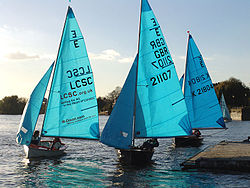Enterprise (dinghy)
| E Class symbol | |
 Enterprises racing on the River Thames | |
| Development | |
|---|---|
| Designer | Jack Holt |
| Year | 1956 |
| Name | Enterprise |
| Boat | |
| Crew | 2 |
| Draft | 8 in (0.20 m) 3 ft 10 in (1.17 m) |
| Hull | |
| Type | Monohull |
| Hull weight | 207 lb (94 kg) |
| LOA | 13 ft 3 in (4.04 m) |
| LOH | 12 ft 11 in (3.94 m) |
| Beam | 5 ft 3 in (1.60 m) |
| Hull appendages | |
| Keel/board type | Centreboard |
| Rig | |
| Rig type | Sloop |
| Sails | |
| Upwind sail area | 115 sq ft (10.7 m2) |
| Racing | |
| D-PN | 92.6[1] |
| RYA PN | 1117[2] |
The Enterprise is a two-man sloop-rigged hiking sailing dinghy with distinctive blue sails. Despite being one of the older classes of dinghies, it remains popular in the United Kingdom and about a dozen other countries, and is used for both cruising and racing. It has a combination of size, weight, and power which appeals to all ages, and to sailing schools. The Enterprise is accredited as an International Class by the International Sailing Federation, the ISAF.
The Enterprise is most often sailed with no spinnaker. However the international class rules allow the decision of whether to allow spinnakers to be made by the national authority. In the U.K. and Canada, no spinnakers were allowed until 2002 when a new PY handicap was introduced in the UK to allow spinnakers to be used in multi class racing in clubs, although spinnakers may still not be used in "Class" racing; in the United States they are allowed.
Early boats, wooden and GRP, used buoyancy bags fixed under the benches and thwarts for internal buoyancy but nowadays foam reinforced plastic boats have built in buoyancy tanks improving stiffness and removing much of the maintenance associated with air-filled bags. Wooden boats still tend to have buoyancy bags to the rear and a forward bulkhead.
They are also relatively unstable in comparison with other dinghies of similar performance, they have handling characteristics which would generally be associated with much faster designs.
Originally "The News Chronicle Enterprise", this predates Jack Holt's other newspaper sponsored Mirror Dinghy as the first UK sailing dinghy to be sponsored by a national newspaper.
The first two Enterprises built were sailed from Dover to Calais both as a test and for advertising purposes. This feat was recreated on the Enterprise's 50th anniversary, but this time the two boats were sailed both to France and back again.
References
- ^ "Centerboard Classes". US Sailing. Retrieved 31 July 2012.
- ^ "Portsmouth Number List 2012". Royal Yachting Association. Retrieved 31 July 2012.
External links
- Enterprise Association UK
- International Enterprise class rules (2013) at www.sailenterprise.org.uk
